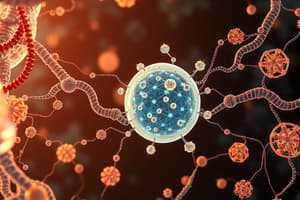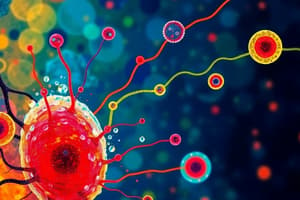Podcast
Questions and Answers
What is the primary function of adenylyl cyclase in the signaling pathway described?
What is the primary function of adenylyl cyclase in the signaling pathway described?
- Transport glucose molecules
- Convert ATP to cAMP (correct)
- Phosphorylate receptor proteins
- Degrade cAMP to AMP
Which of the following statements accurately reflects the role of EGF in its signaling pathway?
Which of the following statements accurately reflects the role of EGF in its signaling pathway?
- EGF is a peptide hormone that binds to a tyrosine kinase receptor. (correct)
- EGF activates G-protein-coupled receptors directly.
- EGF is a steroid hormone that crosses the membrane.
- EGF initiates the process by deactivating adenylate cyclase.
What type of receptor does epinephrine bind to?
What type of receptor does epinephrine bind to?
- Ligand-gated ion channel
- G-protein coupled receptor (GPCR) (correct)
- Nuclear receptor
- Receptor tyrosine kinase
What is the result of activating the EGF signaling pathway?
What is the result of activating the EGF signaling pathway?
Which of the following best describes the amplification event in the transduction pathway?
Which of the following best describes the amplification event in the transduction pathway?
What molecule is primarily responsible for the breakdown of glycogen into glucose 1-phosphate in response to epinephrine?
What molecule is primarily responsible for the breakdown of glycogen into glucose 1-phosphate in response to epinephrine?
In the context of cell signaling, what is the role of the ligand in the discussed pathways?
In the context of cell signaling, what is the role of the ligand in the discussed pathways?
Which of the following statements about peptide hormones, like EGF, is correct?
Which of the following statements about peptide hormones, like EGF, is correct?
What is the role of nitric oxide (NO) in signal transduction?
What is the role of nitric oxide (NO) in signal transduction?
Which of the following is a secondary messenger involved in muscle relaxation?
Which of the following is a secondary messenger involved in muscle relaxation?
How does ginseng potentially affect nitric oxide levels?
How does ginseng potentially affect nitric oxide levels?
What is the primary function of PDE5 in the signaling pathway?
What is the primary function of PDE5 in the signaling pathway?
What cellular response is triggered by the signaling cascade involving nitric oxide?
What cellular response is triggered by the signaling cascade involving nitric oxide?
What is the primary function of the sending cell in cell communication?
What is the primary function of the sending cell in cell communication?
What characterizes autocrine signaling?
What characterizes autocrine signaling?
How do target cells differ from non-target cells in cell signaling?
How do target cells differ from non-target cells in cell signaling?
Why does the signaling pathway involve amplification?
Why does the signaling pathway involve amplification?
What role do chemical signals play in cell communication?
What role do chemical signals play in cell communication?
What type of receptor does nitric oxide act on?
What type of receptor does nitric oxide act on?
What is the function of juxtacrine signaling?
What is the function of juxtacrine signaling?
What effect would Viagra have on the activity of PDE5?
What effect would Viagra have on the activity of PDE5?
What role do cytokines play in direct signaling?
What role do cytokines play in direct signaling?
What is the significance of a threshold concentration in cell signaling?
What is the significance of a threshold concentration in cell signaling?
Which type of signaling is specifically identified as 'cell talking to itself'?
Which type of signaling is specifically identified as 'cell talking to itself'?
What is quorum sensing in bacteria?
What is quorum sensing in bacteria?
How do signal transduction pathways function in relation to environmental stimuli?
How do signal transduction pathways function in relation to environmental stimuli?
What is one key characteristic of paracrine signaling?
What is one key characteristic of paracrine signaling?
Which type of cell communication is essential for distinguishing 'self from non-self'?
Which type of cell communication is essential for distinguishing 'self from non-self'?
What are autoinducers in the context of bacterial communication?
What are autoinducers in the context of bacterial communication?
What does the presence of conserved signaling mechanisms in bacteria and eukaryotes suggest?
What does the presence of conserved signaling mechanisms in bacteria and eukaryotes suggest?
What is a potential outcome of autocrine signaling during development?
What is a potential outcome of autocrine signaling during development?
What system uses plasmodesmata for signaling between cells?
What system uses plasmodesmata for signaling between cells?
What will occur when a killer T-cell binds to an infected cell but cannot kill it?
What will occur when a killer T-cell binds to an infected cell but cannot kill it?
How does quorum sensing (QS) impact the expression of virulence genes in microbes?
How does quorum sensing (QS) impact the expression of virulence genes in microbes?
Which method is most effective to decrease the virulence of a microbe that utilizes quorum sensing?
Which method is most effective to decrease the virulence of a microbe that utilizes quorum sensing?
What is the nature of communication implied in the scenario with a signal-emitting cell and a nearby receptor cell?
What is the nature of communication implied in the scenario with a signal-emitting cell and a nearby receptor cell?
What effect does breaking down the T-cell receptor have on the humoral immune response?
What effect does breaking down the T-cell receptor have on the humoral immune response?
What role do signaling molecules play in quorum sensing?
What role do signaling molecules play in quorum sensing?
If a microbe's ability to communicate via quorum sensing is disrupted, what is likely to occur?
If a microbe's ability to communicate via quorum sensing is disrupted, what is likely to occur?
What is the primary consequence when the helper T-cell cannot bind to the B-cell?
What is the primary consequence when the helper T-cell cannot bind to the B-cell?
What occurs when a signal molecule binds to a GPCR?
What occurs when a signal molecule binds to a GPCR?
Which component is necessary for the activation of a G-protein?
Which component is necessary for the activation of a G-protein?
What happens to a G-protein when it is attached to GDP?
What happens to a G-protein when it is attached to GDP?
Which of the following statements about GPCRs is true?
Which of the following statements about GPCRs is true?
What does the alpha subunit of the G-protein do upon activation?
What does the alpha subunit of the G-protein do upon activation?
What is the role of cAMP in GPCR signaling?
What is the role of cAMP in GPCR signaling?
What initiates the process where a GPCR activates a G-protein?
What initiates the process where a GPCR activates a G-protein?
Why is GTP important in the context of GPCR signaling?
Why is GTP important in the context of GPCR signaling?
Flashcards
Signal amplification in transduction pathways
Signal amplification in transduction pathways
A signaling pathway where the binding of a single signal molecule triggers a cascade of events, amplifying the signal at each step.
G-protein coupled receptor (GPCR)
G-protein coupled receptor (GPCR)
A type of receptor that binds to a signaling molecule and activates a G protein, which in turn activates another molecule, triggering a signal cascade.
Second messenger
Second messenger
A small intracellular molecule that acts as a messenger to relay and amplify signals within the cell.
Epinephrine signaling pathway in glycogen breakdown
Epinephrine signaling pathway in glycogen breakdown
Signup and view all the flashcards
Peptide hormone
Peptide hormone
Signup and view all the flashcards
Ligand
Ligand
Signup and view all the flashcards
Tyrosine kinase receptor
Tyrosine kinase receptor
Signup and view all the flashcards
Target (end) proteins
Target (end) proteins
Signup and view all the flashcards
Cell signaling
Cell signaling
Signup and view all the flashcards
Receptor
Receptor
Signup and view all the flashcards
Signal transduction pathway
Signal transduction pathway
Signup and view all the flashcards
Signal amplification
Signal amplification
Signup and view all the flashcards
Threshold concentration
Threshold concentration
Signup and view all the flashcards
Quorum sensing
Quorum sensing
Signup and view all the flashcards
Cellular response
Cellular response
Signup and view all the flashcards
How to decrease virulence with quorum sensing?
How to decrease virulence with quorum sensing?
Signup and view all the flashcards
Local Communication in Cells
Local Communication in Cells
Signup and view all the flashcards
Impact of T-cell receptor breakdown
Impact of T-cell receptor breakdown
Signup and view all the flashcards
Role of helper T-cells in humoral immunity
Role of helper T-cells in humoral immunity
Signup and view all the flashcards
Signal Transduction
Signal Transduction
Signup and view all the flashcards
Humoral Immune Response
Humoral Immune Response
Signup and view all the flashcards
Impact of a faulty T-cell receptor on killer T-cells
Impact of a faulty T-cell receptor on killer T-cells
Signup and view all the flashcards
Autocrine signaling
Autocrine signaling
Signup and view all the flashcards
Juxtacrine signaling
Juxtacrine signaling
Signup and view all the flashcards
Cell to cell recognition
Cell to cell recognition
Signup and view all the flashcards
Contact inhibition
Contact inhibition
Signup and view all the flashcards
Direct signaling through binding proteins
Direct signaling through binding proteins
Signup and view all the flashcards
Cytokines
Cytokines
Signup and view all the flashcards
Paracrine signaling
Paracrine signaling
Signup and view all the flashcards
Endocrine signaling
Endocrine signaling
Signup and view all the flashcards
First Messenger
First Messenger
Signup and view all the flashcards
Cyclic GMP (cGMP)
Cyclic GMP (cGMP)
Signup and view all the flashcards
What is a G-protein coupled receptor (GPCR)?
What is a G-protein coupled receptor (GPCR)?
Signup and view all the flashcards
What is a G Protein?
What is a G Protein?
Signup and view all the flashcards
What are heterotrimeric G proteins?
What are heterotrimeric G proteins?
Signup and view all the flashcards
What is signal transduction?
What is signal transduction?
Signup and view all the flashcards
What is a ligand?
What is a ligand?
Signup and view all the flashcards
What is a second messenger?
What is a second messenger?
Signup and view all the flashcards
What is signal amplification?
What is signal amplification?
Signup and view all the flashcards
Describe the steps in a G-protein coupled receptor signaling pathway.
Describe the steps in a G-protein coupled receptor signaling pathway.
Signup and view all the flashcards
Study Notes
Cell Communication Overview
- Cells communicate using chemical signals.
- These signals are often proteins or other molecules.
- The sending cell secretes these molecules into the extracellular space.
- These signals can then float to neighboring cells.
- This process is like sending messages in a bottle.
Types of Cell Signaling
- Autocrine: A cell signals to itself.
- Juxtacrine: Cells connected by gap junctions exchange signaling substances directly. Animal cells using gap junctions and plant cells using plasmodesmata.
- Paracrine: A cell targets a nearby cell. Examples include neurotransmitters in synapses, quorum sensing in bacteria, and yeast mating. Paracrine signals are short-range.
- Endocrine: A cell targets a distant cell through the bloodstream. Specialized cells release hormones into the bloodstream, which carries them to their target cells throughout the body.
Signal Transduction
- A signal molecule binds to a receptor protein, changing the receptor's shape.
- Chemical messengers relay the signal.
- This leads to a specific cellular response.
- This process is an example of a cascade because one signal triggers many more downstream effects.
- The receptor activation triggers subsequent proteins and messengers.
- Ultimately, the pathway results in a specific cellular response.
Phosphorylation
- Phosphorylation is the addition of a phosphate group to a molecule.
- This process often activates or deactivates proteins, acting as a sort of "switch."
- The transfer of a phosphate group is catalyzed by an enzyme called a kinase.
- Another type of enzyme, a phosphatase, removes phosphate groups.
Important Things to Know
- Chemical signals allow cells to communicate.
- The distance between signaling and responding cells can vary (small or large).
- There is often a gradient response.
- Threshold concentrations are needed to trigger a communication pathway.
Quorum Sensing
- Bacteria produce autoinducers (signaling molecules).
- When enough bacteria are present (a quorum):
- The concentration of signaling molecules increases.
- Bacteria sense the local population density.
- All bacteria turn on specific functions (eg. bioluminescence, formation of biofilms, or toxin production).
Types of Receptors
- Cell-surface receptors: Embedded in the plasma membrane.
- Intracellular receptors: Located inside the cell (cytoplasm or nucleus). Generally for hydrophobic hormones that can cross the membrane.
G-Protein Coupled Receptors (GPCR)
- A common type of membrane receptor.
- Consists of a receptor protein associated with a G protein.
- G-proteins are proteins involved in relaying chemical signals from outside the cell to inside the cell.
- G-proteins exist in three subunits (alpha, beta, and gamma).
How does a GPCR work?
- The signal molecule binds to the receptor's binding site on the outside of the cell.
- The GPCR undergoes a conformational change. This activates the G protein. . The activated G protein activates a cascade of further compounds, resulting in a change downstream in the cell.
Hormones
- Hormones are signals that travel through the circulatory system.
- Hormones act on distant target cells.
- Hormones are crucial for long-distance communication.
Paracrine Signaling
- Used for short-distance communication between nearby cells.
- Diffusing chemical messengers carry signals.
Synaptic Signaling
- Direct relay of signaling between neurons (a type of paracrine signaling).
- Neurotransmitters carry information across synapses.
Receptor Tyrosine Kinases (RTKs)
- Signal receptors that activate a cascade of reactions.
- Involved in regulating various cellular activities.
Secondary Messengers
- Small, non-protein, water-soluble molecules or ions.
- Diffuse rapidly through a cell to amplify a signal.
- Include cAMP, calcium ions (Ca2+), and inositol triphosphate (IP3).
Positive and Negative Feedback loops
- Positive feedback loops amplify a response by increasing the stimulus.
- Negative feedback loops reduce a response.
Apoptosis
- Programmed cell death, a necessary process for development and homeostasis.
- Triggered by molecular signals activating a cascade of suicide” proteins.
Other Topics
- Different types of plant hormones.
- How antidepressants work.
- Cell signaling in the immune system
- Signal transduction pathways
- The role of ligands in cell signaling.
- Importance to maintaining homeostasis
Studying That Suits You
Use AI to generate personalized quizzes and flashcards to suit your learning preferences.




